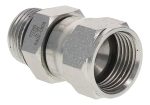Which hydraulic quick couplers suit high-flow applications?

High-flow hydraulic systems need couplers built specifically for moving large volumes of fluid without creating bottlenecks. Standard couplers choke flow and slow down cycle times. Bore diameter, how the internal valves are designed, and the flow path shape all determine actual flow capacity. Large excavators, forestry equipment, and industrial presses need couplers sized for their volumetric demands rather than just pressure ratings.
Large bore diameter
How wide the internal passage is controls fluid volume moving through a coupler. https://northernhydraulics.net/hydraulics-shop/quick-couplers range from quarter-inch up to two inches and bigger. High-flow work typically starts at three-quarter-inch minimum. One-inch and larger handles the volumes these systems demand.
Bore diameter affects flow exponentially instead of linearly. Double the diameter and you get roughly four times the flow capacity. One single one-inch coupler moves more fluid than two half-inch couplers combined. This makes single large couplers more efficient than running multiple smaller ones. Manufacturers publish flow coefficients as Cv values that quantify actual flow capacity. Higher Cv numbers mean better flow. Compare these values when picking couplers instead of just looking at connection size. Internal restrictions matter as much as inlet and outlet diameters.
Valve configuration options
Standard poppet valve designs restrict flow badly. The valve stem sits right in the flow path where fluid has to navigate around it. High-flow designs take different approaches. Flat face couplers use larger valve openings with shorter stroke distances. Screw-to-connect types eliminate poppet valves. Multi-seal designs put sealing at the body interface instead of using internal valves. Sleeve-actuated valves get positioned away from the main flow path. Some high-flow couplers use spring-loaded sleeves that pull valves completely out of the flow stream when connected. This creates a straight-through passage with less turbulence. The mechanism gets slightly more complex, but flow improvements make it worthwhile.
Pressure drop calculations
Pressure lost through couplers directly cuts system efficiency. Every PSI lost to restriction wastes pump energy. High-flow applications need the pressure drop to be kept under 50 PSI at maximum flow rates. Standard couplers often hit over 100 PSI and drop under high flow. Calculate actual pressure drop using manufacturer flow curves:
- Graphs show pressure loss versus flow rate for specific models
- Match your system’s flow requirements to these curves
- Pick couplers where the pressure drop stays reasonable at operating flow
- Temperature rise indicates excessive restriction
- Fluid forced through tight passages generates heat from turbulence and friction
Couplers running hot need upsizing or replacement with better-flowing designs.
Material and construction
- High-flow couplers balance flow capacity against structural strength. Larger bores mean thinner walls at given outside diameters. Material selection becomes critical here. Steel construction handles pressure requirements while allowing large internal passages. Body design affects flow patterns inside the coupler. Smooth internal transitions cut turbulence. Sharp corners and sudden diameter changes create vortices that choke effective flow.
- Quality high-flow couplers feature radiused transitions and streamlined internal geometry. Connection methods vary for high-flow work. Thread connections function but take time to assemble. Push-to-connect styles offer speed. Screw-to-connect provides the straightest flow path by ditching internal valves entirely while keeping connections secure.
Application matching criteria
- Equipment type dictates coupler selection. Large excavators with multi-function hydraulics need quick attachment changes and high flow together. Forestry equipment switching between grapples, shears, and other tools faces similar demands. Industrial presses and injection molding machines move high volumes during operation and benefit from couplers that minimize cycle time through unrestricted flow.
- Agricultural equipment with implement changes throughout seasons requires both flow capacity and environmental durability. Mobile equipment manufacturers often specify coupler standards. ISO 16028 flat face designs see wide adoption. Matching these standards ensures component compatibility across different tool attachments.
High-flow hydraulic couplers demand large bore diameters and application-appropriate designs. Bore size establishes the foundation for flow capacity. Valve design determines actual restriction levels. Pressure drop calculations verify performance meets requirements. Material choices balance strength against flow needs for specific operating conditions.



















